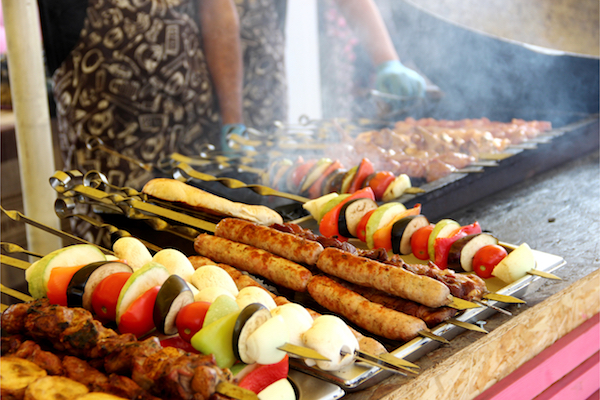The scent of smoldering wood lingering upon the crisp autumn air recently motivated us to gather some friends around a flame of our own. From outdoor hearths and brick ovens to bonfires and fire pits, we love an opportunity to enjoy nature’s chill while dining near the heat of a crackling blaze. However, this fall, we were encouraged to think beyond sliders and s’mores. Following the tradition of our South American friends who have made “barbecue” an art that is [somewhat] rooted in equestrian sport, we discovered the asado.
asado /aˈsaðo/: Spanish, noun
The techniques and social event of a barbecue in various South American countries, typically consisting of beef, pork, chicken, chorizo, and morcilla, which are cooked on a grill (a parrilla) or an open fire, and are accompanied by red wines and salads.
The Cliffsnotes:
Comparing an asado to a Western BBQ is a bit of an injustice to a culture that abstains from smothering meat in sauces while browning it over a gas grill. In Argentina, meat is served naked, flavored only by hot coals and coarse salt. This simple technique has not changed much since the 1800s when Argentine cowboys used it to keep themselves fed while working the plains surrounding Buenos Aires. The asado has evolved into a social tradition (much in the way we do Sunday brunch), and has even become synonymous with polo matches.
In order to satiate our appetite for authenticity, we approached native Argentine and equestrian friend Martin Videla and his wife Rachel, and inquired about their secrets to a DIY asado after devouring a feast of their production last week. The Videlas recently relocated their hunter/jumper farm, Rancho Pampa, from Buenos Aires to Aiken, South Carolina, with their grill skills in tow. While they train, coach, compete, and raise a family here in the States, the Videlas make an annual trek or two to Argentina with clients who are in search of a new mount along with some cultural immersion: basically, a ride-until-you-are-blissfully-saddle-sore horse shopping vacation (more on that in a few weeks) with a lot of good food.
In the meantime, they are also known to stoke a fire or two for friends (like us), forever changing the way we “grill out.”
The Full Story:

The grill and the flame are two very important but separate tools.
The grill must be raised with enough room to shovel hot coals beneath its grate, since meat and vegetables are not cooked directly over the flame, which is stoked in a nearby pit or firebox to heat the coals. Then, the piping hot coals are continuously transferred from the fire to the underside of the grill, which should be placed at a slight angle so that juices travel away from the heat, preventing flare ups from dripping grease.
The fire must be very hot.
It is best to prepare the fire at least one hour in advance of cooking to really toast the coals. People think the key to tasty meat is marinating it all day, when in fact all that is needed is a hot fire, a bit of salt, and patience—meat should be slow-cooked for tenderness and flavor.

Combine your favorite meats.
The traditional asado uses a whole animal, but for the amateur culinary enthusiast, a grill of mixed meats is not uncommon, and usually consists of sausage links along with beef and pork tenderloin. Place the meat in the center of the grill, where it is hottest, and position skewered vegetables (see below) around the edge of the grill. Slice the meat as it is served.
Fresh ingredients are a must for sauces.
Again, asado meats are not marinated. Instead, they are garnished with fresh chimichurri or tomato salsa that is served on the side to be drizzled on top. A healthy amount of red pepper is added for heat and flavor. Plates are mopped with fire-toasted bread, or the bread is used to make a sandwich for the meat.

There’s always a starter.
Argentines start with “picada,” which literally translates to little bites and usually consists of salami, prosciutto, sliced cheeses (often Pategras or Gouda or even Camembert), fresh bread, green olives, and chips.
Keep the sides simple!
Salads, or ensalada mixta, are simply lettuces topped with tomatoes and white onions dressed with oil and vinegar. Even a vegan can enjoy an asado because of the abundance of grilled vegetables, like pearl onions, colorful bell peppers, and green and yellow squash on skewers. Vegetables are rough cut so that they are chunky and hearty. Then, baby potatoes are wrapped in tin foil and nestled between ashes and coals until they are cooked to perfection (take into account the intensity of your fire)!

Dulces!
It’s easy to whip up a batch of Alfajores (creamy caramel sandwiches) or Pepitas (a jam thumbprint cookie with a dollop of quince). Both are a favorite in Argentine households and finish off a heavy meal with just the right amount of light, sugary sweetness.
And of course, the wine.
The red’er the better! Pair your asado with a signature Argentine Malbec, such as those from the high-altitude vineyards of Terrazas del los Andes that have been OR-tested alongside the Videlas handiwork. High-altitude wines are celebrated for their intense flavors, and their vintners are revered for taking the risks–while not for the faint of heart, steep, rocky terroir, dry air, intense sunlight, and cold nights literally give grapes a thick skin, preserving tannins, increasing minerality, and prolonging ripening, resulting in a coveted low alcohol/high acidity ratio.
An Outdoor Entertaining Checklist
We’ve drawn from our archives for a few of our favorite tools and tips when dining afuera:
Stock up on these flyaway sticks for pest-free barbecues;
Use shatterproof, equestrian-inspired tableware;
Get or gift a handsome and functional apron;
Grab a stylish hat (and sunscreen!) for sun protection; and
Cut branches and flowers for handmade centerpieces!








